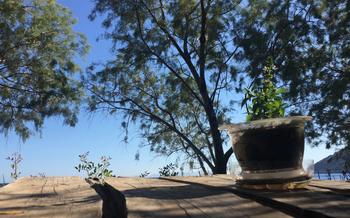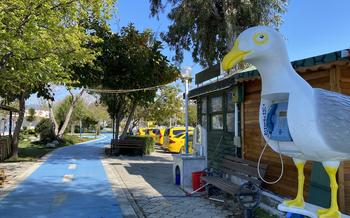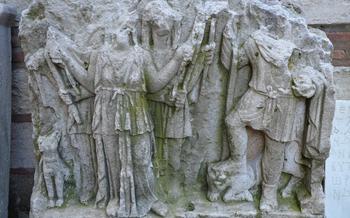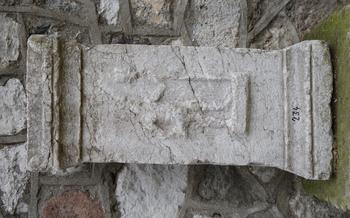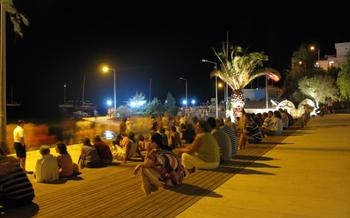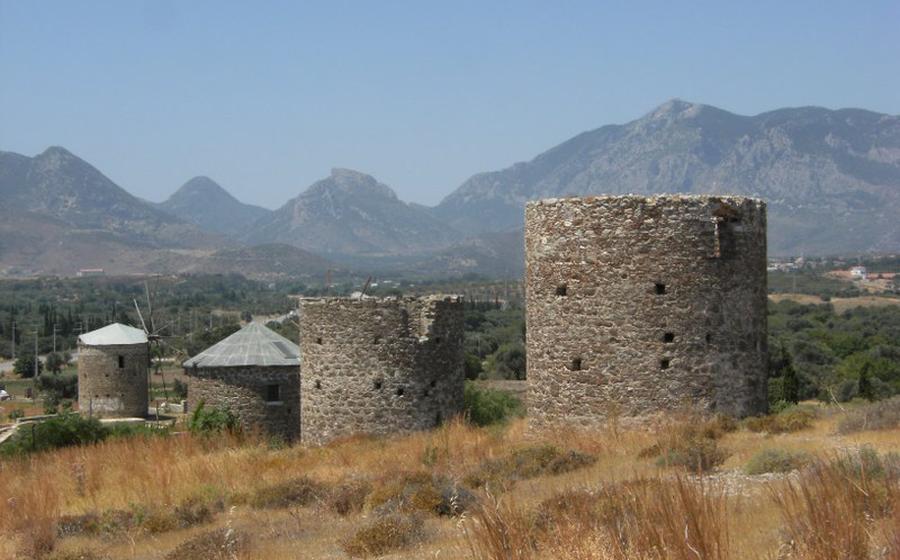
Alavara Ruins
- Alavara Ruins: Antiquity Unveiled
- Tracing the Footsteps of History
- Exploring the Archaeological Treasures
- Alavara's Alluring Setting
- A Walk Through Time: Uncovering Alavara's Layout
- Alavara: A Crossroads of Cultures
- Alavara and the Datça Peninsula
- Alavara's Enduring Legacy
- Planning Your Visit: Practical Considerations
- Capturing the Essence of Alavara: Photography Tips
- Alavara in Local Folklore and Mythology
- Sustainability and Responsible Tourism
- Recommended Duration for a Visit
- Accessibility and Facilities for Visitors
- Insider Tip: Unleashing Your Inner Explorer
Alavara Ruins: Antiquity Unveiled
Step into the forgotten city of Alavara, where history whispers from the very stones. Nestled amidst picturesque olive groves, overlooking the breathtaking views of the Aegean Sea, the Alavara ruins stand as a testament to a glorious past. Unearth the remnants of a once-thriving settlement, where tombs, cisterns, and fortification walls narrate tales of ancient civilizations. Embark on a journey through time, revealing the secrets of a city shrouded in mystery and intrigue.
Plan your odyssey to Alavara with ease. From the charming town of Datça, embark on a scenic drive or hop aboard a local bus. Let the countryside unravel as you approach the ruins, where history awaits your exploration.
Tracing the Footsteps of History
Step into the annals of time as you explore the fascinating history of Alavara, an ancient city with roots that stretch back to the 5th century BC. Unearth the vestiges of a Hellenistic civilization, where influences from the Classical world shaped the city's architecture and artifacts. Discover the remnants of a Byzantine fortress, a testament to the city's strategic importance during the Byzantine era. And marvel at the imprints of Ottoman rule, including a watchtower that stands sentinel over the site, offering breathtaking panoramic views of the surrounding landscape. Alavara stands as a testament to the rich tapestry of civilizations that have graced this land, inviting you on a journey through time to uncover its captivating stories.
Exploring the Archaeological Treasures
Alavara's ruins offer a treasure trove of archaeological wonders that transport visitors back in time. The city's fortifications, once impenetrable barriers against invaders, stand as testaments to the ingenuity and resilience of its ancient inhabitants. Explore the remnants of these mighty walls, marveling at their strategic design and the sheer scale of their construction.
Unearth the secrets of the past as you venture into the ancient tombs scattered throughout the site. These subterranean chambers, once the final resting places of Alavara's citizens, provide glimpses into their funerary customs and beliefs. Decipher the inscriptions adorning the tombstones, each telling a unique story of life, death, and the afterlife.
Discover the ingenious water storage systems that sustained Alavara's population. Cisterns, meticulously carved into the rock, collected and stored rainwater, ensuring a vital supply during the dry summer months. Admire the intricate engineering of these underground reservoirs, a testament to the city's advanced hydraulic knowledge.
Finally, let your gaze be drawn to the remnants of intricate mosaics that once graced the floors of Alavara's buildings. These colorful and detailed artworks depict scenes from mythology, nature, and everyday life, offering a glimpse into the artistic sensibilities and cultural influences that shaped this ancient city.
Alavara's Alluring Setting
Alavara is not just about ancient ruins; it is also a place of scenic beauty. The ruins are nestled amidst olive groves, creating a picturesque backdrop that transports visitors to a different era. From the site, visitors can capture breathtaking views of the Datça Peninsula and the sparkling Aegean Sea. The region's unique ecosystem supports a diverse array of plant life, including endemic species, which adds to the allure of the site. After exploring the ruins, visitors can unwind and bask in the sun at nearby secluded beaches, offering a tranquil escape and a chance to soak in the beauty of the surrounding nature.
A Walk Through Time: Uncovering Alavara's Layout
Strolling through the ruins of Alavara is akin to embarking on a journey through time, uncovering the intricate layout of a once-thriving city. Explore the remains of residential areas, where houses and other structures provided shelter to Alavara's inhabitants. Discover the remnants of marketplaces, temples, and other public gathering places that served as the heart of the city's social and economic life. Investigate the elaborate fortifications that protected Alavara from potential threats, showcasing the city's strategic importance. Delve into the sophisticated water systems that supplied the city's needs, demonstrating the ingenuity of its ancient engineers. Each step taken amidst these ruins paints a vivid picture of Alavara's past, inviting visitors to become part of its enduring story.
Alavara: A Crossroads of Cultures
Throughout its existence, Alavara served as a meeting point for diverse cultures and civilizations, each leaving their unique imprint on the city. Greek influences are evident in the architectural styles and artifacts found at the site, showcasing the Hellenistic heritage of the region. Roman rule left behind coins, pottery, and other remnants, offering glimpses into the period when Alavara fell under Roman dominion.
With the arrival of Christianity, Byzantine influences transformed Alavara, as evidenced by the remains of churches and other religious structures. The city's strategic location made it a significant center during the Byzantine era, and its fortifications played a crucial role in protecting the region from potential threats.
The Ottoman conquest brought about further changes to Alavara, as the city adapted to the new ruling power. Ottoman watchtowers were constructed, and existing structures were repurposed to suit the needs of the new inhabitants. These architectural remnants serve as a testament to the blending of cultures that occurred during this period.
Exploring Alavara's rich cultural heritage provides a glimpse into the diverse influences that shaped this ancient city, making it a fascinating destination for history enthusiasts and travelers seeking to unravel the layers of civilizations that once thrived in this region.
Alavara and the Datça Peninsula
Just 12 kilometers from the charming town of Datça, Alavara presents itself as an ideal day trip destination. Discover the idyllic landscapes of the Datça Peninsula, where turquoise waters meet verdant shores. Enhance your visit to Alavara by exploring other nearby attractions, such as the captivating Datça Museum. Journey back in time at the Knidos Ancient City, or immerse yourself in the tranquility of the peninsula's pristine beaches. Delight your palate with the region's delectable cuisine, featuring the freshest seafood, locally-grown produce, and authentic Turkish dishes. Unwind in one of Datça's charming guesthouses or immerse yourself in the luxury of its resorts, creating a memorable and holistic experience.
Alavara's Enduring Legacy
The story of Alavara is one of abandonment, rediscovery, and ongoing preservation. After its decline and eventual desertion, the city lay forgotten for centuries, its ruins gradually being reclaimed by nature. It wasn't until the 20th century that Alavara was rediscovered and brought back into the light. Archaeological excavations commenced, revealing the city's rich history and cultural significance.
Today, the ruins of Alavara stand as a testament to the enduring legacy of ancient civilizations. Archaeological excavations continue to shed light on the city's past, uncovering new insights into its daily life, architecture, and cultural practices. Preservation efforts are underway to protect and conserve the ruins for future generations, ensuring that Alavara's story continues to be told.
Despite its abandonment, Alavara remains a significant historical and cultural heritage site. Its ruins offer a glimpse into the lives of the people who once called this city home, providing valuable insights into the ancient world. Whether you're a history buff, an archaeology enthusiast, or simply someone who appreciates the beauty of ancient ruins, Alavara is a destination that should not be missed.
Planning Your Visit: Practical Considerations
Alavara welcomes visitors throughout the year, offering an immersive journey into its ancient past. To make the most of your visit, plan your trip during the spring or autumn months (April-May and September-October) when the weather is at its best. The site is typically open during daylight hours, with nominal entrance fees that contribute to its preservation and maintenance.
Guided tours are available for those seeking a deeper understanding of Alavara's history and significance. These tours often provide insights into the site's archaeological discoveries, architectural features, and the daily lives of its inhabitants.
Essential amenities such as restrooms and drinking water are limited, so it's advisable to come prepared. You can find cafes and restaurants in nearby Datça, where you can savor the region's culinary delights after your exploration.
Capturing the Essence of Alavara: Photography Tips
Alavara's ancient ruins offer a treasure trove of photographic opportunities for capturing the essence of this historical site. To make the most of your photography experience, consider the following tips:
-
Lighting conditions: The best lighting for photography at Alavara is during the golden hours, just after sunrise and just before sunset. During these times, the warm, diffused light casts a beautiful glow on the ruins, enhancing their textures and details.
-
Angles and perspectives: Experiment with different angles and perspectives to create visually appealing and unique shots. Try shooting from low angles to capture the grandeur of the ruins against the sky, or from high vantage points to showcase the site's layout and surroundings.
-
Composition and framing: Pay attention to the composition and framing of your shots to create balanced and visually pleasing images. Consider using leading lines, such as paths or walls, to draw the viewer's eye into the image.
-
Equipment recommendations: A wide-angle lens is ideal for capturing sweeping vistas of the ruins, while a telephoto lens can be used to focus on specific details or distant objects. A tripod can help stabilize your camera for sharp shots, especially in low-light conditions.
Alavara in Local Folklore and Mythology
Alavara is not just a historical site but also a place deeply embedded in local folklore and mythology. Legends and myths have been passed down through generations, weaving a tapestry of stories around the ruins. One popular legend tells of a hidden treasure buried beneath the ruins, guarded by ancient spirits who protect it from those who seek to claim it. Another myth speaks of a beautiful princess who was imprisoned within the walls of Alavara, her cries echoing through the ruins at night. Locals believe that the ruins possess a mystical energy, and some claim to have experienced strange phenomena or unexplained occurrences while visiting the site. These stories and beliefs add an extra layer of intrigue and enchantment to the already captivating allure of Alavara.
Sustainability and Responsible Tourism
As you explore the Alavara Ruins, it's essential to practice responsible tourism and minimize your impact on the environment and the local community. Here are some tips to ensure your visit is sustainable and respectful:
-
Protect the Environment: Avoid littering and properly dispose of any waste you generate during your visit. Respect the natural surroundings by staying on designated paths and avoiding disturbing the local flora and fauna.
-
Respect Local Customs: Familiarize yourself with local customs and traditions to ensure you behave respectfully and avoid any misunderstandings. Dress appropriately and be mindful of noise levels and public behavior.
-
Support Local Businesses: Consider supporting local businesses, such as restaurants and shops, to contribute to the local economy and sustain the community. This helps preserve the unique character of the region and supports the livelihoods of local people.
-
Leave No Trace: Practice the principle of "leave no trace" by cleaning up after yourself and leaving the site as you found it. Avoid disturbing historical artifacts or structures, and respect the integrity of the ruins for future generations.
Recommended Duration for a Visit
The ideal duration for a visit to Alavara depends on your interests and the level of exploration you prefer. If you're seeking a quick overview of the site, allocate around two hours for a self-guided tour. This will allow you to wander through the ruins, admire the fortifications and tombs, and capture some stunning photographs.
For a more immersive experience, consider spending half a day or more at Alavara. This will provide ample time to explore at your own pace, read the information panels, and delve deeper into the history of the city. You can also opt for a guided tour, which typically lasts for around two hours and offers valuable insights from a knowledgeable guide.
Combining your visit to Alavara with other nearby attractions is a great way to make the most of your time in the area. The Datça Museum, Knidos Ancient City, and the stunning beaches of the peninsula are all within easy reach. Plan a full-day excursion to explore these diverse attractions and immerse yourself in the rich history and natural beauty of the Datça Peninsula.
Accessibility and Facilities for Visitors
Alavara is committed to providing an accessible and enjoyable experience for all visitors. The site features designated pathways and ramps to ensure that visitors with disabilities or limited mobility can navigate the ruins with ease. Ample parking spaces are available near the site, including designated areas for disabled drivers.
While exploring the ruins, visitors can take advantage of the restrooms and drinking water fountains located conveniently throughout the site. Informative maps and guidebooks are available at the entrance to provide visitors with a deeper understanding of Alavara's history and significance. Additionally, visitors can benefit from the expertise of knowledgeable guides who offer guided tours, providing insights into the site's unique features and historical context.
Insider Tip: Unleashing Your Inner Explorer
As you explore the Alavara ruins, embrace your inner explorer and seek out hidden gems that offer unique perspectives and lesser-known historical details. Venture beyond the main tourist areas to discover off-the-beaten-path adventures in the surrounding countryside, where you might stumble upon ancient artifacts or breathtaking views. Engage with locals to uncover their favorite spots or lesser-known stories about Alavara and the region. Capture the essence of your journey through photography, travelogue, or social media posts, sharing your unique experiences and perspectives to inspire others to explore the hidden treasures of this ancient city.
